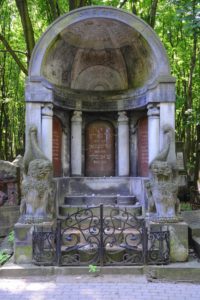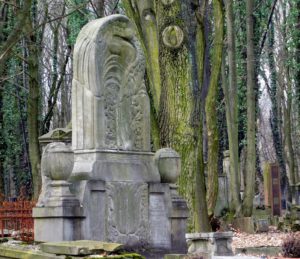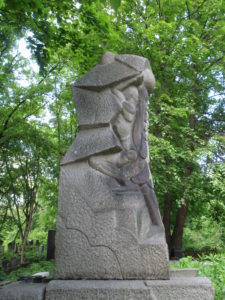Abraham Ostrzega – T2 prisoner
He was born in 1889 in Okuniewo near Radzymin into religious Jewish family. He received traditional education at Białystok’s and Brest’s yeshivas. He trained his sculpting skills in Henryk Kuna’s workshop. Then started studies at the School of Fine Arts in Warsaw.
At the beginning, his work was of historical and portrait nature. Sculptures such as the Prophet and Maimonides come from this period. He was a laureate and participant in many competitions and exhibitions. He was involved in the activities of the Society for the Encouragement of Fine Arts and was the initiator of the creation of the Jewish Society of Promoting of Fine Arts. He also designed decorations for theatrical purposes.
Abraham Ostrzega was known as a sculptor of monuments. He made tombstones in cemeteries in Warsaw and Łódź. His sculptures were characterized by expressionist and geometric forms. In his works he referred to the art of ancient Mesopotamia and Egypt, as well as the Judaic tradition. Ostrzega’s sculptures often featured such motifs as: an image of an angel; a door symbol denoting the gate to a new life, and allegorical figures. The grave sculptures made by Ostrzega were often considered to violate the religious prohibition of showing a human face, therefore they were often removed and destroyed.
In the 1930s, Ostrzega ran the Atelier of Decorative Arts at. Mylna 9a street in Warsaw, which was located in the Warsaw Ghetto during the War. Then, he transformed the atelier into a whetstone factory where he employed his friends who were artists. In this way, he wanted to protect them from hunger and deportations to camp. In the summer months of 1942, the whetstone factory was included into szop AHAGE-Zimmermann [szopy (plural) were factories in the ghetto producing for the Germans]. On August 25, 1942, Abraham Ostrzega and friends of his were transported to the German Nazi Extermination Camp Treblinka II, were they died.
During World War II, a large part of the sculptor’s works was destroyed. The preserved works of Ostrzega are currently present in the Jewish cemetery in Warsaw (around 60) and in Łódź. The most famous monuments by Abraham Ostrzega include: the Mausoleum of Three Writers (Icchok Lejb Perec, Jakub Dinezon and Szymon An-Ski); the tombstone of Hirsz Dowid Nomberg (Member of the Polish Patliament); the grave of Jan Sierota, the sculpture of Paradise Bird on Julian Hopfenstand’s tombstone; the sculpture Motherhood on Józef Poznański’s grave; and Horace Heller’s sarcophagus and the tomb of Jeager manufacturers in Łódź.
Source: Tarnowska M., Ostrzega Abraham, [w:] Polski Słownik Judaistyczny, red. Z. Borzymińska, R. Żebrowski, t. 2, Warszawa 2003; http://www.jhi.pl/psj/Ostrzega_Abraham [dostęp: 16.10.2020]; https://sztetl.org.pl/pl/biogramy/5911-ostrzega-abraham; Szubert P., Abraham Ostrzega, [w:] Culture.pl,http://culture.pl/pl/tworca/abraham-ostrzega;https://1943.pl/wystawy/wirtualna-wystawa-ludzie-miejsca-wydarzenia.
Photographs: the Mausoleum of Three Writers (Icchok Lejb Perec, Jakub Dinezon and Szymon An-Ski); the tombstone of Stanisław Heyman in Łódź (Poland); Carved in rock – an example of a symbolic sculpture on the grave of Jan Sierota in Warsaw. [public domain]
A.R
Translation: P.M








